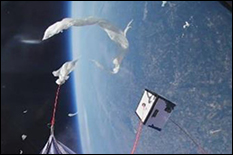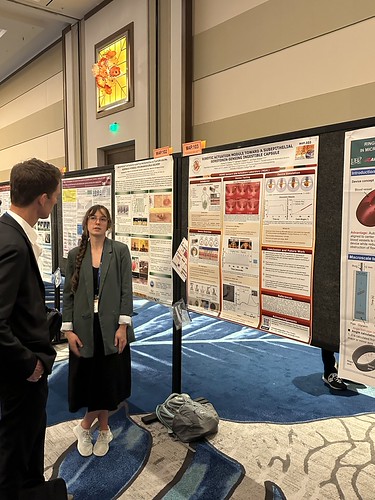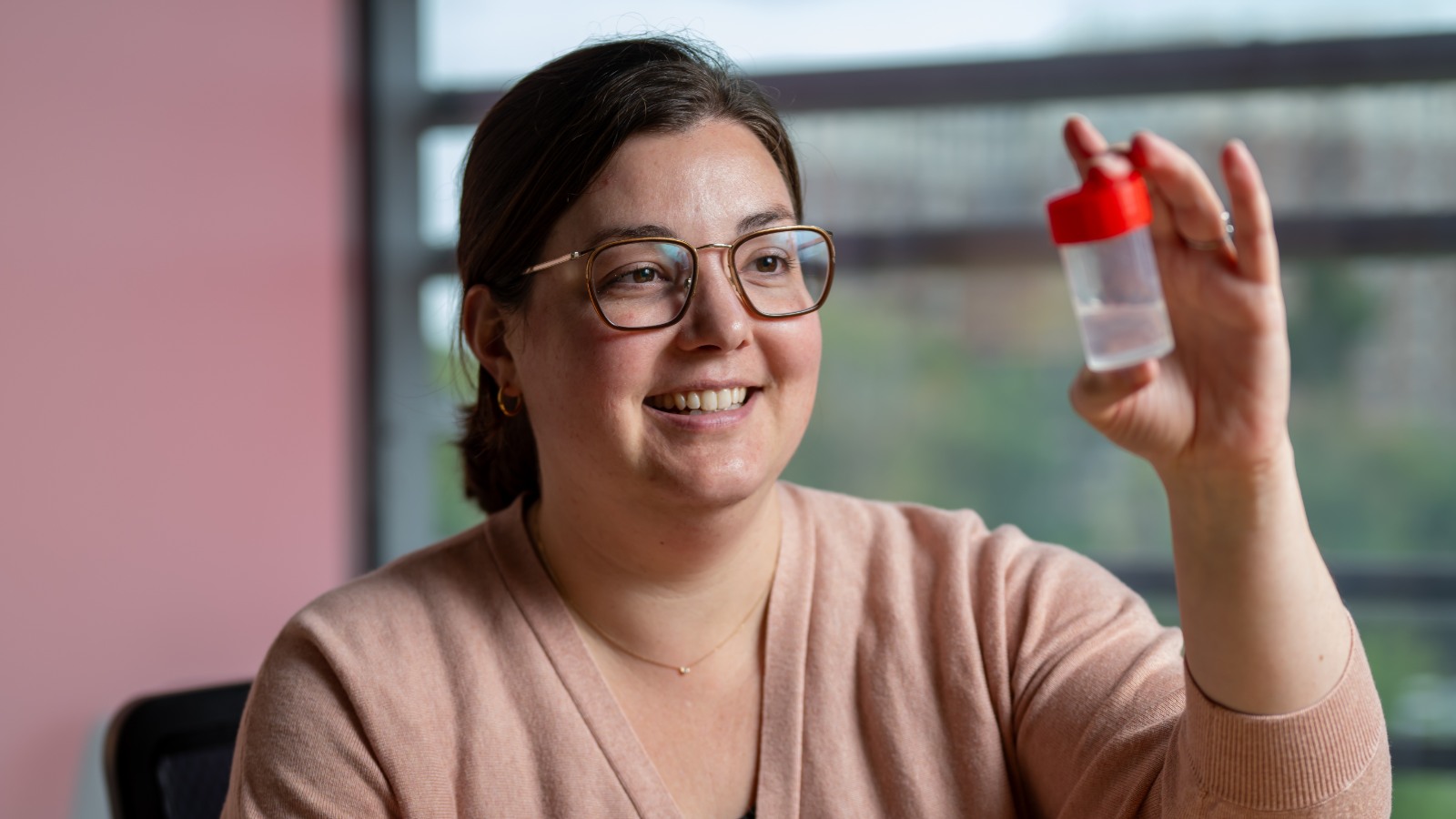News Story
Examining Microbiology from New Heights

In recent years, researchers have discovered that bacteria that make their way to the Earth’s upper atmosphere might actually have a direct impact on our weather and climate.
While scientists have long acknowledged the presence of these “high-flying” bacteria populations, there is still little known about how high-altitude colonies of bacteria can affect weather, or what causes the concentrations of these bacteria to change over time.
Recognizing this, 19-year-old Caitlyn Singam, a rising University of Maryland senior majoring in biological sciences, set out to develop a low-cost way for scientists to gather data about the atmospheric environment and the airborne bacteria that find their way miles above the Earth’s surface. Singam is working under the guidance of William E. Bentley, director of the university’s Robert E. Fischell Institute for Biomedical Devices, to design and test a self-contained system to collect microbiological samples present at high altitudes, using what are commonly known as weather balloons.
“The long-term goal is to democratize the science involved, so that people can collect longitudinal data from anywhere, across the country and across the world, about different microbiological profiles of the atmosphere, to see what sorts of things live at various altitudes and to determine whether that changes based upon the geography of the region below,” Singam said.
It’s easy to assume that our planet’s upper atmosphere would be a virtual dead zone for biological life due to the cold temperatures, high levels of radiation, and low barometric pressure native to the miles-high environment. The reality, however, is that there are large colonies of microorganisms that find their way to both the troposphere – the layer of the atmosphere that extends from the Earth’s surface to anywhere from six to 12 miles high – and the stratosphere – the layer that stretches from the troposphere to about 30 miles above the Earth’s surface. In fact, scientists have even found evidence of microbial life in the ionosphere, the “transition layer” between the other layers of the Earth’s atmosphere and outer space, and where levels of solar radiation are extraordinarily high.
Yet, scientists only recently determined that some of the microbes that make their way to the upper atmosphere might impact cloud formation. In 2010, researchers conducted one of the very first studies of atmospheric microbiology by analyzing samples collected during a NASA-led hurricane research mission. The resulting paper, published in the Proceedings of the National Academy of Sciences in 2013, revealed that some high-altitude microbes can cause ice crystals to form in the atmosphere – a key first step in the process of cloud formation.
The findings undoubtedly changed what scientists think about the world of atmospheric microbiology; but the flight mission and sample collection process proved expensive.
In order for scientists to understand the bigger picture – how bacteria populations scattered across different locations and layers of the Earth’s atmosphere might contribute to weather events or even climate change – they need a lot of data. And, in order for that data to prove meaningful, researchers would need to collect dozens – if not hundreds or thousands –of samples, from a wide variety of locations across the Earth’s atmosphere, in order to identify correlations with weather events and climate. As such, it would be virtually impossible for scientists to rely exclusively on flight time aboard specialized planes to gather the data they would need to advance understanding in this field.
That is where Singam aims to make a difference.
By equipping scientists with an easy-to-navigate, low-cost system for atmospheric monitoring and sample collection, Singam believes we will learn more about the atmospheric environment and what role it plays in weather, climate change, or even the spread of airborne diseases.
“We don’t yet really know what these high-altitude microbes are like,” Singam said. “They provide a really interesting link between the ground and the air. Considering that people often like to separate aerospace from biology, these microbes represent a link that no one has really investigated yet.”
The upper portion of Singam’s system consists of four sample chambers constructed using low-cost household materials, such as polystyrene foam and plastic wrap. The bottom portion of the system holds the microprocessors and sensors, allowing users to access these devices without contaminating any samples they collect.
To facilitate sample collection, Singam designed a drawbridge mechanism using a servo that allows microorganisms to collect onto an agar to be captured. Singam specially designed the system to withstand changes in barometric pressure and sub-freezing temperatures. She also attached an ultra-fine fiber to each of the system’s doors so that, when either opens, the fiber breaks. This would offer confirmation that, should a flight return few or no microbe samples, it would reveal telling information about the chosen sample site in the atmosphere, rather than leave researchers questioning if their results stemmed from a mechanical failure in the system.
Because the system relies on a weather balloon to reach high elevations, it costs users nearly 100 times less than what they would pay to collect samples using a piloted aircraft equipped to do the same. Even more, because the balloon simply rises through the air, it creates much less turbulence than a plane would during flight. Compared with the plane, the balloon flight minimizes the likelihood that any atmospheric bacteria colonies in the flight path would be disturbed in such a way that would alter sampling results.
Singam had the opportunity to test a prototype of her device via a weather balloon flight test in 2018. The results were encouraging; the sensors worked according to plan, and the system’s sample collection mechanism triggered appropriately.
Next, to develop a control test of the device, Singam is working with Koken Co. Ltd., the Japan-based makers of a specialized clean air device known as the Koach T500 portable ultra clean room air purifier. Koken recently partnered with the Fischell Institute to loan the device in efforts to advance this and other research efforts.
The Koach T500 is a tabletop device that uses two push hoods stationed across from one another to generate purified, coherent airflows to create a clean zone with an air cleanliness level rated at ISO Class 1. Singam is working to test her system using the Koach device to determine if her system will work appropriately during its next flight. Additionally, she will use it to test the extent to which the capturing mechanism will collect microbes that might be several inches or feet away from the device, especially when wind shear is a factor.
To showcase the device and to learn more about Singam’s research, Koken deputy manager Yuji Toyoshima traveled from Japan to visit the Fischell Institute earlier this spring.
Singam herself is no stranger to the Fischell Institute. As a 17-year-old freshman, Singam won the 2017 America’s Got Regulatory Science Talent competition, hosted by the UMD Center of Excellence in Regulatory Science and Innovation (M-CERSI). She was recognized by representatives of the U.S. Food and Drug Administration for her proposed universal labeling system to help individuals identify hazardous drugs.
Moving forward, Singam hopes to pursue both an M.D. and a Ph.D. after she earns her undergraduate degree.
“It has been my goal to pursue a very well-rounded education, supplemented by the belief that modern medicine will greatly benefit from engineering disciplines,” she said.
Singam's work was recently featured on ABC7 Washington. View the segment online.
Published May 28, 2019






